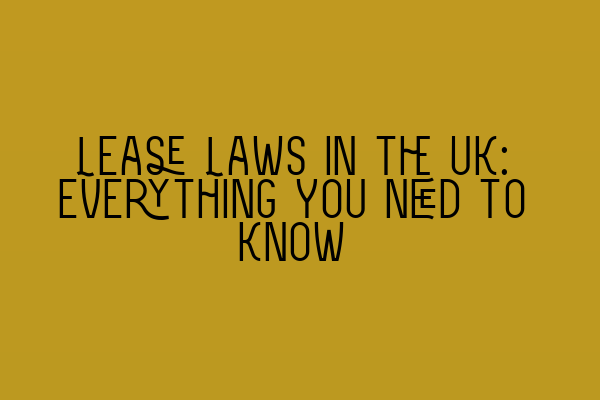LEASING LAWS IN THE UK: EVERYTHING YOU NEED TO KNOW
Welcome to SQE Property Law & Land Law! As experts in the field, we understand that lease laws can be complex and confusing. That’s why we’re here to provide you with an in-depth guide on lease laws in the UK. Whether you’re a property owner, landlord, tenant, or simply curious about lease agreements, this blog post will cover everything you need to know. So, let’s dive right in!
Before we begin, it’s essential to clarify what a lease is. In the context of property law, a lease is a legally binding contract between a landlord (the property owner) and a tenant (the person renting the property). This contract outlines the terms and conditions of the tenancy, including rent payments, duration, responsibilities, and more.
TYPES OF LEASES
There are several types of leases in the UK, each with its own characteristics and legal implications. It’s important to understand the different types to ensure you’re entering into the right lease agreement. Here are the most common types:
1. Assured Shorthold Tenancy (AST) – This is the most common type of tenancy in the UK and is typically used for residential properties. ASTs provide certain rights and protections for both landlords and tenants.
2. Commercial Lease – This type of lease is used for non-residential properties, such as offices, retail spaces, and industrial units. Commercial leases often involve more complex terms and negotiation.
3. Long Lease – Also known as a leasehold, a long lease typically lasts for more than 21 years. It grants the tenant certain rights and obligations while the property is under lease.
4. Short Lease – A short lease, on the other hand, typically lasts for less than 21 years. It may have specific terms and restrictions depending on the agreement.
LEASING PROCESS
Now that we’ve outlined the various types of leases, let’s delve into the leasing process. Whether you’re a landlord or a tenant, it’s important to understand the steps involved in securing or granting a lease:
1. Negotiation – This is the stage where the tenant and landlord determine the key terms of the lease, including the duration, rent amount, payment terms, and any additional clauses or conditions.
2. Agreement – Once the negotiation is complete, both parties will need to sign the lease agreement to make it legally binding. It’s crucial to read and understand the terms before signing, as it will define your rights and obligations as a tenant or landlord.
3. Payment and Deposit – Tenants are typically required to pay a security deposit before moving into the property. This deposit acts as a financial safeguard for the landlord and can be used to cover any damages or unpaid rent. It’s important to understand the rules and regulations surrounding security deposits to protect yourself as a tenant.
4. Commencement – The lease agreement will specify the start date of the tenancy. On this date, the tenant can move into the property and start paying rent.
RIGHTS AND RESPONSIBILITIES
Now that you have a basic understanding of the leasing process, let’s discuss the rights and responsibilities of both landlords and tenants:
Landlord Rights and Responsibilities:
– The right to receive rent payment on time and in full.
– The responsibility to maintain the property in a safe and habitable condition.
– The right to enter the property for inspections or repairs, with proper notice.
– The responsibility to protect the tenant’s deposit in a government-approved deposit protection scheme.
Tenant Rights and Responsibilities:
– The right to live in a safe and well-maintained property.
– The responsibility to pay rent on time and in full.
– The right to privacy and quiet enjoyment of the property.
– The responsibility to report any damages or repairs required promptly.
DISPUTE RESOLUTION
Unfortunately, disputes may arise between landlords and tenants, despite their best efforts. In the event of a dispute, it’s essential to know your rights and the available avenues for resolution. Here are a few methods commonly used in the UK:
1. Mediation – This is a voluntary, impartial process where a third party helps the disputing parties communicate and reach a mutually satisfactory resolution. Mediation can be a cost-effective and time-efficient way to resolve lease disputes.
2. Arbitration – In arbitration, disputing parties submit their case to an independent arbitrator who will make a legally binding decision. This process is more formal than mediation and may involve legal representation.
3. Court Proceedings – In some cases, lease disputes may need to be resolved through court proceedings. This can be a lengthy and costly process, so it’s advisable to explore alternative dispute resolution methods first.
CONCLUSION
Lease laws in the UK govern the relationship between landlords and tenants, protecting both parties and ensuring fair treatment. Understanding lease types, the leasing process, rights, responsibilities, and dispute resolution methods is crucial for anyone involved in leasing property.
At SQE Property Law & Land Law, we’re dedicated to providing you with expert guidance and advice on all aspects of lease laws. Whether you’re a landlord or a tenant, we’re here to help you navigate the complexities of lease agreements.
For more information and resources on property law, lease agreements, and SQE preparation, be sure to explore our other articles:
– SQE 1 Practice Exam Questions
– SQE 1 Practice Mocks FLK1 FLK2
– SQE 2 Preparation Courses
– SQE 1 Preparation Courses
– SRA SQE Exam Dates
For any further assistance or legal inquiries, don’t hesitate to contact our team of experienced solicitors. We’re here to support you every step of the way.
